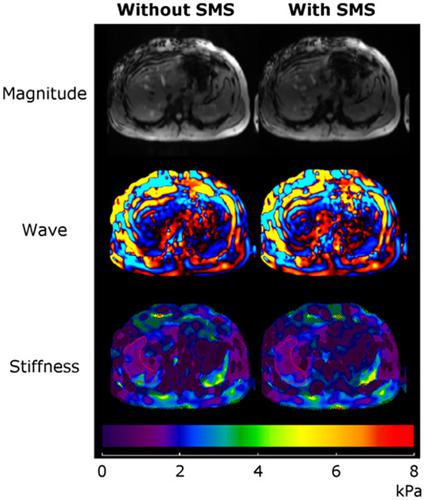当前位置:
X-MOL 学术
›
NMR Biomed.
›
论文详情
Our official English website, www.x-mol.net, welcomes your
feedback! (Note: you will need to create a separate account there.)
Simultaneous multislice rapid magnetic resonance elastography of the liver.
NMR in Biomedicine ( IF 2.7 ) Pub Date : 2020-01-23 , DOI: 10.1002/nbm.4252 Waqas Majeed 1 , Prateek Kalra 1 , Arunark Kolipaka 1, 2, 3
NMR in Biomedicine ( IF 2.7 ) Pub Date : 2020-01-23 , DOI: 10.1002/nbm.4252 Waqas Majeed 1 , Prateek Kalra 1 , Arunark Kolipaka 1, 2, 3
Affiliation

|
To design and validate a rapid Simultaneous Multi-slice (SMS) Magnetic Resonance Elastography technique (MRE), which combines SMS acquisition, in-plane undersampling and an existing rapid Magnetic Resonance Elastography (MREr) scheme to allow accelerated data acquisition in healthy volunteers and comparison against MREr. SMS-MREr sequence was developed by incorporating SMS acquisition scheme into an existing MREr sequence that accelerates MRE acquisition by acquiring data during opposite phases of mechanical vibrations. The MREr sequence accelerated MRE acquisition by acquiring data during opposite phases of mechanical vibrations. Liver MRE was performed on 23 healthy subjects using MREr and SMS-MREr sequences, and mean stiffness values were obtained for manually drawn regions of interest. Linear correlation and agreement between MREr- and SMS-MREr-based stiffness values were investigated. SMS-MREr reduced the scan time by half relative to MREr, and allowed acquisition of four-slice MRE data in a single 17-second breath-hold. Visual comparison suggested agreement between MREr and SMS-MREr elastograms. A Pearson's correlation of 0.93 was observed between stiffness values derived from MREr and SMS-MREr. Bland-Altman analysis demonstrated good agreement, with -0.08 kPa mean bias and narrow limits of agreement (95% CI: 0.23 to -0.39 kPa) between stiffness values obtained using MREr and SMS-MREr. SMS can be combined with other fast MRE approaches to achieve further acceleration. This pushes the limit on the acceleration that can be achieved in MRE acquisition, and makes it possible to conduct liver MRE exams in a single breath-hold.
中文翻译:

肝脏的同步多层快速磁共振弹性成像。
设计和验证快速同步多层 (SMS) 磁共振弹性成像技术 (MRE),该技术结合了 SMS 采集、平面内欠采样和现有的快速磁共振弹性成像 (MREr) 方案,以加速健康志愿者的数据采集和与 MREr 的比较。SMS-MREr 序列是通过将 SMS 采集方案合并到现有的 MREr 序列中开发的,该序列通过在机械振动的相反阶段采集数据来加速 MRE 采集。MREr 序列通过在机械振动的相反阶段采集数据来加速 MRE 采集。使用 MREr 和 SMS-MREr 序列对 23 名健康受试者进行肝脏 MRE,并获得手动绘制的感兴趣区域的平均硬度值。研究了基于 MREr 和 SMS-MREr 的刚度值之间的线性相关性和一致性。SMS-MREr 相对于 MREr 将扫描时间减少了一半,并允许在一次 17 秒的屏气中采集四层 MRE 数据。视觉比较表明 MREr 和 SMS-MREr 弹性图之间的一致性。在源自 MREr 和 SMS-MREr 的刚度值之间观察到 Pearson 相关性为 0.93。Bland-Altman 分析显示出良好的一致性,使用 MREr 和 SMS-MREr 获得的刚度值之间具有 -0.08 kPa 的平均偏差和狭窄的一致性限制(95% CI:0.23 至 -0.39 kPa)。SMS 可以与其他快速 MRE 方法相结合,以实现进一步的加速。这推动了 MRE 采集中可实现的加速度的极限,并使得在一次屏气中进行肝脏 MRE 检查成为可能。
更新日期:2020-03-09
中文翻译:

肝脏的同步多层快速磁共振弹性成像。
设计和验证快速同步多层 (SMS) 磁共振弹性成像技术 (MRE),该技术结合了 SMS 采集、平面内欠采样和现有的快速磁共振弹性成像 (MREr) 方案,以加速健康志愿者的数据采集和与 MREr 的比较。SMS-MREr 序列是通过将 SMS 采集方案合并到现有的 MREr 序列中开发的,该序列通过在机械振动的相反阶段采集数据来加速 MRE 采集。MREr 序列通过在机械振动的相反阶段采集数据来加速 MRE 采集。使用 MREr 和 SMS-MREr 序列对 23 名健康受试者进行肝脏 MRE,并获得手动绘制的感兴趣区域的平均硬度值。研究了基于 MREr 和 SMS-MREr 的刚度值之间的线性相关性和一致性。SMS-MREr 相对于 MREr 将扫描时间减少了一半,并允许在一次 17 秒的屏气中采集四层 MRE 数据。视觉比较表明 MREr 和 SMS-MREr 弹性图之间的一致性。在源自 MREr 和 SMS-MREr 的刚度值之间观察到 Pearson 相关性为 0.93。Bland-Altman 分析显示出良好的一致性,使用 MREr 和 SMS-MREr 获得的刚度值之间具有 -0.08 kPa 的平均偏差和狭窄的一致性限制(95% CI:0.23 至 -0.39 kPa)。SMS 可以与其他快速 MRE 方法相结合,以实现进一步的加速。这推动了 MRE 采集中可实现的加速度的极限,并使得在一次屏气中进行肝脏 MRE 检查成为可能。











































 京公网安备 11010802027423号
京公网安备 11010802027423号